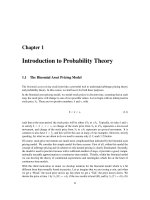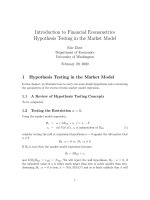AI p0 introduction to AI course
Bạn đang xem bản rút gọn của tài liệu. Xem và tải ngay bản đầy đủ của tài liệu tại đây (2.21 MB, 34 trang )
GIỚI THIỆU VỀ TRÍ TUỆ
NHÂN TẠO
GV. Nguyễn Thị Hải Bình
Khoa Công nghệ thông tin
Đại học Giao thông vận tải
AI IN FICTION
GV. Nguyễn Thị Hải Bình
2
AI IN REALITY
GV. Nguyễn Thị Hải Bình
3
GV. Nguyễn Thị Hải Bình
4
GV. Nguyễn Thị Hải Bình
5
WHAT IS BIOLOGICAL INTELLIGENCE?
• Sensory processing (xử lý giác quan)
• Visual cortex (vỏ thị giác)
• Auditory cortex (vỏ thính giác)
• Somatosensory cortex (vỏ xúc giác)
• Motor cortex (vỏ vận động)
• Cognitive functions (chức năng nhận thức)
•
•
•
•
•
Memory (ghi nhớ)
Reasoning (suy luận)
Executive control (kiểm soát điều hành)
Learning (học)
Language (ngôn ngữ)
Slide credit: Joelle Pineau ()
6
WHAT IS BIOLOGICAL INTELLIGENCE?
• A mix of general-purpose and special-purpose
algorithms
• General-purpose
• Memory formation, updating, retrieval
• Learning new tasks
• Special-purpose
• Recognizing visual patterns
• Recognizing sounds
• Learning language
• All are integrated seamlessly
Slide credit: Joelle Pineau ()
7
WHAT IS AI?
• “The exciting new effort to make computers think
… machines with minds.” (Haugeland, 1985)
• “The automation of activities that we associate
with human thinking, activities such as decisionmaking, problem solving, learning …” (Bellman,
1979)
• “The art of creating machines that perform
functions that require intelligence when perform
by people.” (Kurzwell, 1990)
GV. Nguyễn Thị Hải Bình
8
WHAT IS AI?
• “The study of mental faculties through the use of
computational models.” (Charniak and McDermott,
1985)
• “The study of the computations that make it
possible to perceive, reason, and act.” (Winston,
1992)
• “Computational Intelligence is the study of the
design of intelligence agents.” (Poole et al., 1998)
GV. Nguyễn Thị Hải Bình
9
WHAT IS AI?
Thinking Humanly
(Suy nghĩ như con người)
Thinking Rationally
(Suy nghĩ hợp lý)
Acting Humanly
(Hành động như con người)
Acting Rationally
(Hành động hợp lý)
GV. Nguyễn Thị Hải Bình
10
ACTING HUMANLY: TURING TEST
• AI is all about duplicating what the human brain
does
• Can a machine think? If it could, how would we
tell? (Alan Turing)
• Turing test
• Loebner contest
Slide credit: Joelle Pineau ()
11
ELIZA AND ALICEBOT
• Remarkably simple “Rogerian Psychologist”
• Uses Pattern Matching to carry on limited form of
conversation.
• Seems to “Pass the Turing Test!” (McCorduck, 1979,
pp. 225-226)
• />• />
GV. Nguyễn Thị Hải Bình
12
ACTING RATIONALLY
(HÀNH ĐỘNG HỢP LÝ)
• Rational behavior = doing the “right” thing.
• Doing what is expected to maximize goal
achievement, given the available information and
available resources.
• Does not necessarily require thinking (e.g. blinking
reflex).
• But in many cases, thinking serves rational behavior.
• This is the flavor of AI we will focus on.
Slide credit: Joelle Pineau ()
13
BIG PICTURE
• Agent (Tác nhân)
• Tiếp nhận (perceiving) thông tin từ môi trường thông
qua cảm biến (sensors)
• Phản ứng (acting) lại thông qua các bộ phân hoạt động
(actuators)
Figure credit: Joelle Pineau ()
14
Artificial Intelligence: A Modern Approach (3nd ed.),
Figure 2.2 A vacuum-cleaner world with just two locations
GV. Nguyễn Thị Hải Bình
15
AI BEGINNINGS
• ENIAC: First super-computer, created in 1946
• Early work in 1950s:
• Rosenblatt’s perceptron
• Samuel’s checkers player
• Dartmouth Conference (1956)
• Term “Artificial intelligence”
GV. Nguyễn Thị Hải Bình
16
EARLY AI HOPES AND DREAMS
• Make programs that exhibit similar signs of
intelligence as people: prove theorems, play chess,
have a conversation.
• Logical reasoning was key.
• Learning from experience was considered
important.
• Building general problem solvers.
• There was a lot of hope that natural language
could be easily understood and processed.
Slide credit: Joelle Pineau ()
17
RECENT AI
• Heavy use of probability theory, decision theory,
statistics.
• Trying to solve specific problems rather than aim
for general reasoning.
• Reasoning is now the part named ``AI'' .
• A lot of progress was made in this way!
• Some recent efforts try to put all this together (e.g.
in robotics).
GV. Nguyễn Thị Hải Bình
18
AI SYSTEM: CHESS PLAYING (1997)
• IBM Deep Blue defeats Garry Kasporov
• Perception: advanced features of the board
• Action: choose a move
• Reasoning: search and evaluation of possible board
positions
Slide credit: Joelle Pineau ()
19
AI SYSTEM: POKER PLAYING (2008)
Slide credit: Joelle Pineau ()
20
AI SYSTEM: IBM WATSON (2011)
Slide credit: Joelle Pineau ()
21
GV. Nguyễn Thị Hải Bình
22
AI SYSTEM: MEDICAL DIAGNOSIS
(1992)
• Pathfinder (D. Heckerman, Microsoft Research)
• Perception: symptoms, test result.
• Action: suggest tests, make diagnosis.
• Reasoning: Bayesian inference, machine learning,
Monte-Carlo simulation.
Slide credit: Joelle Pineau ()
23
AI SYSTEM: READING THE MIND
(2008)
• Brain Image Analysis (T. Mitchell, CMU)
• Perception: brain imaging using fMRI technology.
• Actions: detect which word (e.g. “hammer”,
“apartment”, …) is being read by the human subject.
• Reasoning: statistical machine learning.
Slide credit: Joelle Pineau ()
24
AI SYSTEM: HANDWRITING
RECOGNITION (2003)
Slide
credit:
()
Joelle
Pineau
25
![[CEH V3] Introduction to Ethical Hacking](https://media.store123doc.com/images/document/13/ly/ap/medium_3ABUW8WdDH.jpg)








